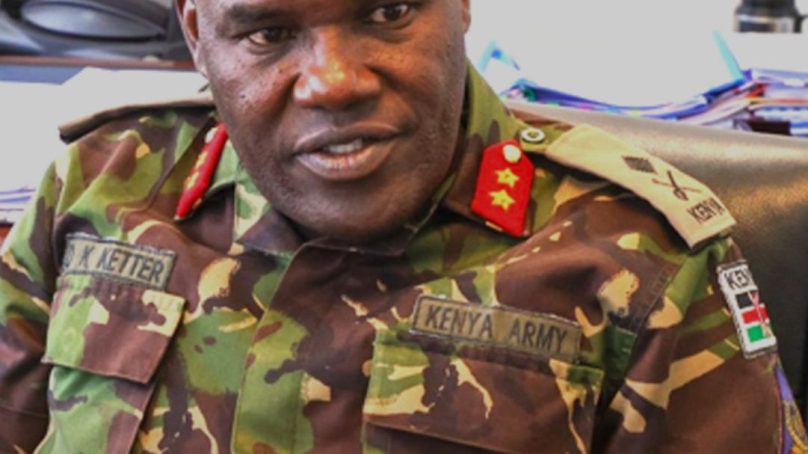
Kenya’s President William Ruto and his cabinet now claim the June 25 protests were a coup d’état to oust him and his government from power.
An unusually timid Ruto – a pointer he had been shaken by threats by protesters to storm Parliament and State House – said calls for his resignation or removal from power were inspired by hate. He did not specify the source of hate – whether ethnicity, religion, politics or personal.
But it is in public domain that the presidents presides over the most corrupt government since independence 61 years ago, and public service is dominated by his Kalenjin community at the expense of the most qualified Kenyans from other communities.
As if to mock critics, President Ruto on Friday promoted four members of his Kalenjin community to generals of the Kenya Defence Force (KDF). Maj-Gen David Kipkemboi Ketter was promoted to Lieutenant General and appointed him as the Commander Kenya Army, place in line for succession when Chief of Defence Forces Charles Kahiriri ends his tour of duty as army chief.
Lt-Gen Ketter replaced Lt-Gen David Kimaiyo Chemwaina Tarus, another Kalenjin, who was moved to National Defence University as the Vice Chancellor.
Ruto also promoted and appointed Brigadier Joyce Chelang’at Sitienei to the rank of Major General and moved her Deputy Vice Chancellor Centre for Strategic and Security Studies at National Defence University.
While Ruto president, head of Civil Service Felix Koskei, Deputy Inspector General of Police Eliud Lagat and Interior Minister Murkomen, among other are Kalenjin.
In the civil service Kalenjins are either at the top of key government ministries and institutions or are deputise people from other communities, creating what the public views as an overload of a single community in plum appointments.
On Friday, while President Ruto appeared cured of bravado by the searing criticism and withered public anger over marginalisation of the rest of the country over distribution of resources, he said he would no relinquish power.
“If you want Ruto to go, develop a better plan than the one I have. The one that exists. If you truly love Kenya as you say, don’t burn the country. Don’t be part of the problem; figure out how to be part of the solution. If you hate the leaders, violence is not a solution to any challenges Kenya is facing. Therefore, if your problems are anchored on hate, your protests anchored on hate… people think it is fashionable… but if you continue that way, we will not have a country.”
Ruto’s Minister for Interior Kipchumba Murkomen accused protesters on of attempting to overthrow the government during a day of deadly demonstrations, remarks that protest leaders said were an attempt to deflect attention from their demands.
In the aftermath of the protests that brought the entire country to a halt, Murkomen gave orders to police to shoot-on-sight anybody they perceive as a threat to “national security.” The order since been criticised by human rights activists and envoys accredited to Nairobi, forcing the minister to backtrack.
Murkomen said at least 10 people had been killed in the previous day’s unrest, when youth-led demonstrations were followed by looting and arson in Nairobi and other cities. The rights group Amnesty Kenya said at least 16 people were killed, all by gunshots, which it said were suspected to have been fired by police.
In an amplification of Murkomen’s statements, President Ruto warned: “Do not tell us you hate so and so and (sic) you have no strategy. You cannot replace the plan that is in place without a plan. You are armed with hate, really? I want to ask the religious and political leaders who are encouraging this movement towards violence and chaos and anarchy… what is your plan?”
He warned that Kenya risks sliding into anarchy.
“If we go this route, we will not have a country. And the country does not belong to William Ruto –it belongs to all of us. And if there is no country for William Ruto, there is no country for you,” he told religious leaders.
Thousands of Kenyans participated in Wednesday’s demonstrations, initially called to mark the anniversary of anti-government protests last year, and amplified by public anger over the death this month of a blogger in police custody.
Murkomen told a press briefing on Thursday that the protesters were trying to enact “regime change”, and said police had been forced to hold back large crowds who sought to approach parliament and State House, the president’s residence.
“Criminal anarchists” had “unleashed a wave of violence, looting, sexual assault and destruction upon our people,” Murkomen said.
Boniface Mwangi, one of the prominent figures in the protest movement, observed: “The branding of yesterday’s protests as a coup is the government’s attempt to shift attention from the real issue.”
Ibrahim Hamisi, owner of one of the burnt-out buildings in central Nairobi, said the government and the protesters, informally known in Kenya as Gen Z, needed to open dialogue.
“Look: everything they burnt. So please government, try talking to the Gen Z,” he said. “So, the Gen Z, try to sit down and talk with the government.”
Josephine Apondi, among shopkeepers cleaning up, said “thugs” had looted two million shillings ($15,500) worth of phones and electronics from her shop.
The demonstrations were called to mark the anniversary of anti-tax protests a year ago, when more than 60 people were killed.
They also follow weeks of fresh demonstrations in response to the death of blogger Albert Ojwang, 31, jailed as part of a police response to a complaint filed by the deputy national police chief, Eliud Lagat.
Prosecutors have approved murder charges against six people, including three police officers, over Ojwang’s death. All six have pleaded not guilty. it was not possible to reach Lagat for comment.
- A Tell Media report / Additional reporting by Reuters







